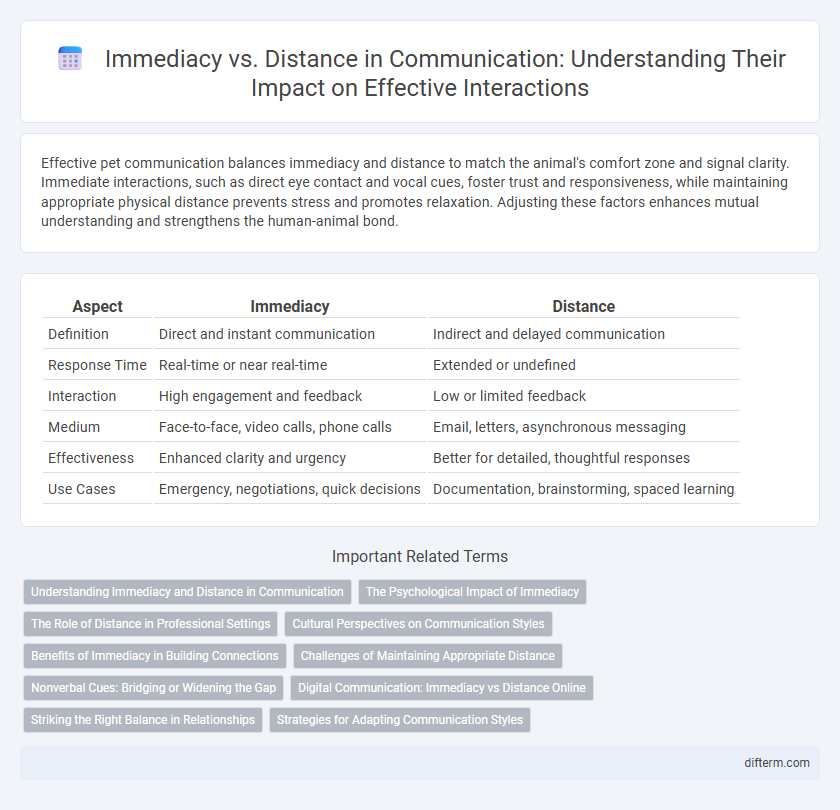Effective pet communication balances immediacy and distance to match the animal's comfort zone and signal clarity. Immediate interactions, such as direct eye contact and vocal cues, foster trust and responsiveness, while maintaining appropriate physical distance prevents stress and promotes relaxation. Adjusting these factors enhances mutual understanding and strengthens the human-animal bond.
Table of Comparison
| Aspect | Immediacy | Distance |
|---|---|---|
| Definition | Direct and instant communication | Indirect and delayed communication |
| Response Time | Real-time or near real-time | Extended or undefined |
| Interaction | High engagement and feedback | Low or limited feedback |
| Medium | Face-to-face, video calls, phone calls | Email, letters, asynchronous messaging |
| Effectiveness | Enhanced clarity and urgency | Better for detailed, thoughtful responses |
| Use Cases | Emergency, negotiations, quick decisions | Documentation, brainstorming, spaced learning |
Understanding Immediacy and Distance in Communication
Immediacy in communication involves behaviors that enhance psychological closeness, such as eye contact, open body language, and vocal expressiveness, fostering stronger interpersonal connections and trust. Distance, both physical and emotional, creates a sense of formality and deters intimacy, often used in professional or unfamiliar interactions to maintain boundaries. Balancing immediacy and distance is crucial for effective communication, influencing message clarity, relational dynamics, and the overall interaction outcome.
The Psychological Impact of Immediacy
Immediacy in communication fosters psychological closeness, enhancing feelings of trust, warmth, and connection between individuals. This phenomenon reduces social distance, promoting openness and increasing the effectiveness of interpersonal interactions. Psychological studies reveal that immediacy behaviors, such as eye contact, tone of voice, and body language, significantly improve relational satisfaction and emotional bonding.
The Role of Distance in Professional Settings
Distance in professional settings significantly impacts communication efficiency and relationship building, often necessitating deliberate strategies to bridge physical or virtual gaps. Maintaining immediacy through timely responses, clear messaging, and the use of video conferencing tools enhances collaboration and reduces misunderstandings. Organizations leveraging technology to simulate face-to-face interactions can foster trust, engagement, and productivity even across remote teams.
Cultural Perspectives on Communication Styles
Cultural perspectives on communication styles reveal significant variations in immediacy and distance preferences, with high-context cultures emphasizing indirect, relationship-focused interactions and low-context cultures favoring explicit, direct exchanges. For example, East Asian cultures often maintain greater physical and emotional distance to show respect, while Latin American and Mediterranean cultures exhibit higher immediacy through close proximity and expressive gestures. Understanding these cultural norms is essential for effective intercultural communication, reducing misunderstandings, and fostering positive relational dynamics.
Benefits of Immediacy in Building Connections
Immediacy enhances communication by fostering stronger emotional bonds and trust between individuals, which accelerates relationship development. Immediate feedback reduces misunderstandings and facilitates clearer, more effective exchanges of ideas. This proximity in interaction promotes a sense of presence and attentiveness, boosting engagement and mutual understanding.
Challenges of Maintaining Appropriate Distance
Maintaining appropriate distance in communication presents challenges such as balancing clarity and emotional connection while avoiding misunderstandings caused by excessive immediacy or detachment. Digital platforms often blur boundaries, making it difficult to interpret tone and intent accurately. Ensuring effective communication requires constant adjustment to context, audience, and medium to sustain professional and personal relationships without overstepping privacy or appearing distant.
Nonverbal Cues: Bridging or Widening the Gap
Nonverbal cues such as eye contact, body language, and facial expressions play a crucial role in bridging the gap between immediacy and distance in communication by conveying emotions and intentions beyond words. Misinterpretation or absence of these cues, especially in digital communication, can widen the emotional distance, leading to misunderstandings and reduced empathy. Effective use of nonverbal signals enhances relational closeness and clarity, fostering better engagement regardless of physical proximity.
Digital Communication: Immediacy vs Distance Online
Digital communication balances immediacy and distance by enabling instant interaction through messaging apps, video calls, and social media platforms while maintaining physical separation. Real-time communication tools like Zoom and WhatsApp foster immediacy, improving collaboration and emotional connection despite geographic barriers. However, asynchronous methods such as email preserve distance, allowing users flexibility in response time and thoughtful engagement.
Striking the Right Balance in Relationships
Striking the right balance between immediacy and distance in communication fosters trust and emotional security, essential components in healthy relationships. Maintaining appropriate proximity through timely responsiveness and respecting personal boundaries enhances mutual understanding and reduces conflicts. Effective communication practices that calibrate presence and space create stronger, more resilient connections.
Strategies for Adapting Communication Styles
Effective communication requires adapting styles to balance immediacy and distance based on context and audience. Strategies include adjusting tone, using appropriate nonverbal cues, and selecting the right medium to convey urgency or formality. Tailoring messages by considering cultural norms and relationship dynamics enhances clarity and engagement in both personal and professional interactions.
immediacy vs distance Infographic

 difterm.com
difterm.com